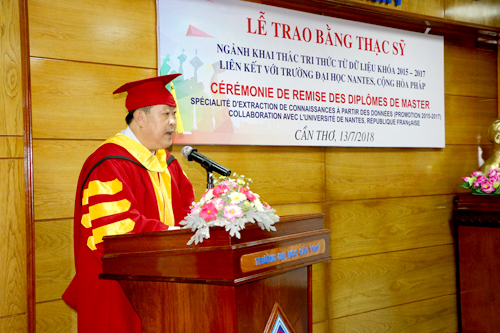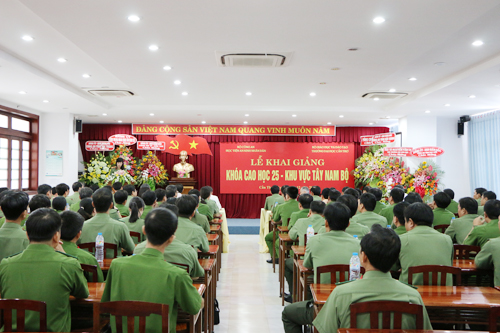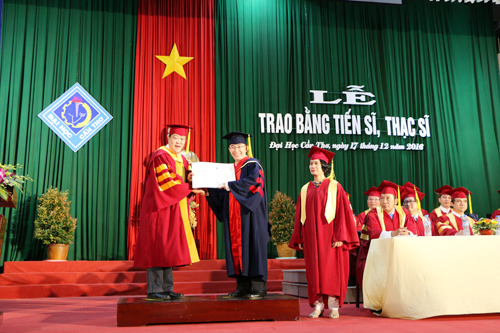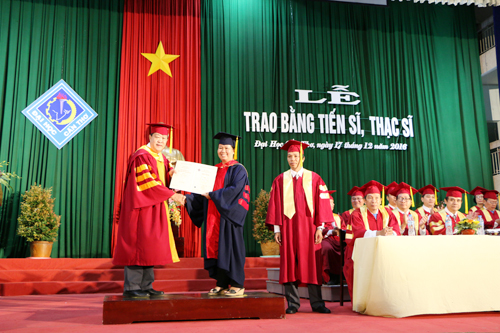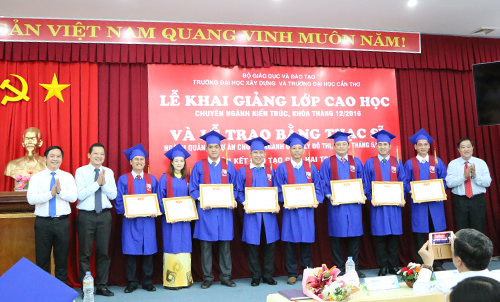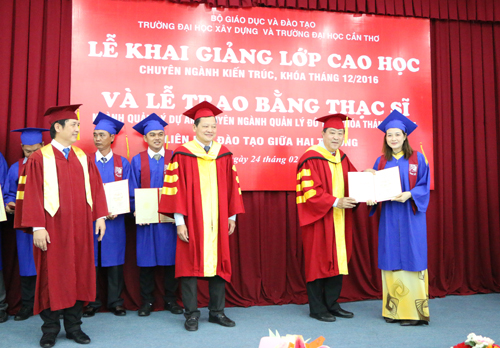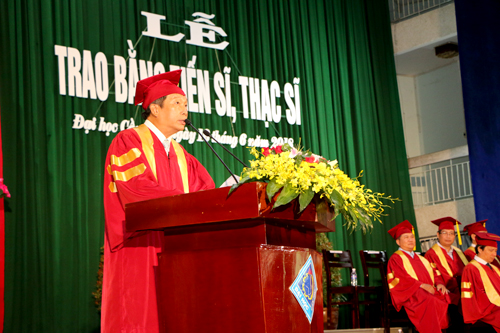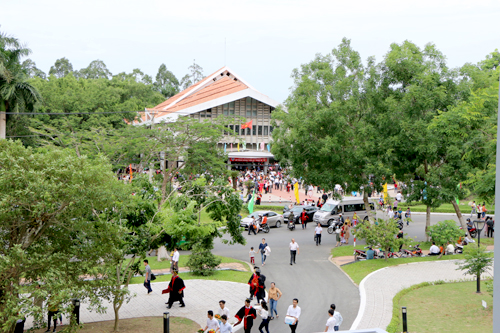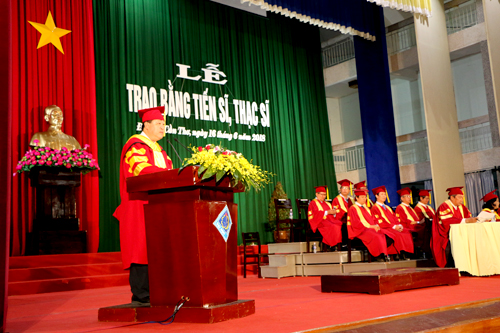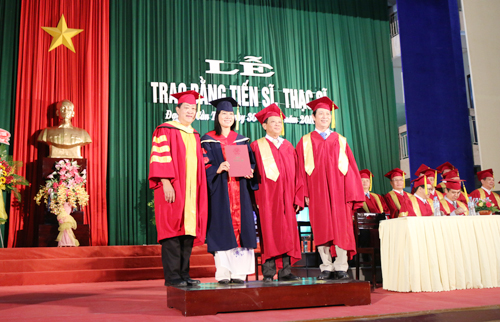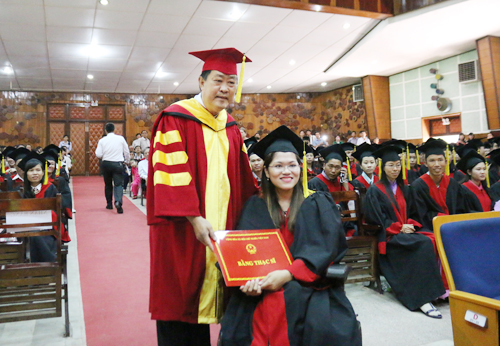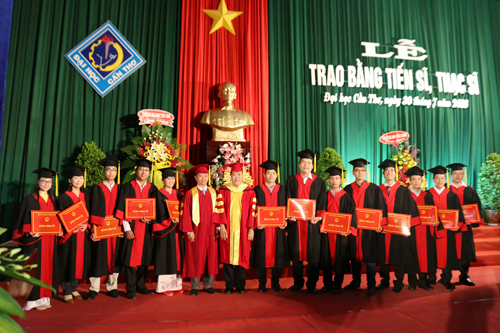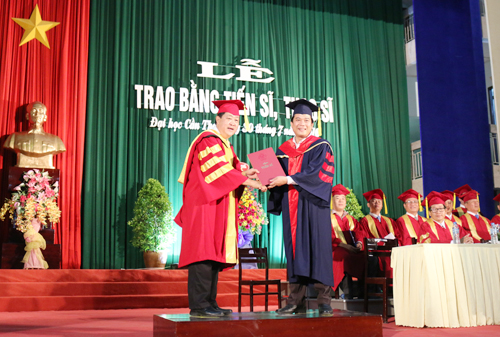
Tên đề tài: Nghiên cứu thu nhận sản phẩm lên men phối hợp có khả năng hỗ trợ làm tan huyết khối và khử gốc tự do
Tác giả: Lý Huỳnh Liên Hương, Khóa: 2019
Ngành: Công nghệ sinh học; Mã số: 9420201. Nhóm ngành: Khoa học sự sống
Người hướng dẫn: PGS.TS. Nguyễn Văn Thành - Trường Đại học Cần Thơ
- Tóm tắt nội dung luận án
Nghiên cứu được thực hiện nhằm phát triển chế phẩm sinh học lên men phối hợp có khả năng ly giải huyết khối và khử gốc tự do, hướng đến ứng dụng hỗ trợ điều trị bệnh lý tim mạch liên quan đến cục máu đông và stress oxy hóa. Hai chủng vi khuẩn tiềm năng được sử dụng gồm Bacillus subtilis TO46 sinh enzyme nattokinase và Komagataeibacter nataicola TD6 sinh acid glucuronic, được phân lập từ nguồn vi sinh vật bản địa tại Đồng bằng Sông Cửu Long thông qua cấy trải trên môi trường chọn lọc, sàng lọc đặc điểm hình thái - sinh hóa, và đánh giá hoạt tính đặc hiệu. Quy trình lên men được tối ưu hóa bằng phương pháp bề mặt đáp ứng theo phương án cấu trúc có tâm (RSM–CCD), nhằm xác định điều kiện thích hợp về pH, nhiệt độ, thời gian và nồng độ cơ chất. Kết quả cho thấy B. subtilis TO46 đạt hoạt tính nattokinase tối đa là 198,02 FU/mL, K. nataicola TD6 đạt hàm lượng acid glucuronic cao nhất là 102,23 µg/mL. Cả hai sản phẩm lên men được tinh sạch sơ bộ và đánh giá hoạt tính sinh học bao gồm hoạt tính ly giải fibrin và khả năng ức chế sự oxy hóa lipid. Hai hợp chất sinh học sau đó được phối hợp thử nghiệm in vivo trên mô hình chuột nhắt trắng bị gây huyết khối bằng κ-carrageenan. Các chỉ số huyết tương D-dimer, triglyceride, LDL-C, HDL-C và mô học mạch máu được phân tích. Kết quả cho thấy sự phối hợp giữa enzyme nattokinase và acid glucuronic giúp làm tan huyết khối hiệu quả hơn, cải thiện đáng kể các thông số huyết tương, và bảo vệ nội mô mạch máu tốt hơn so với từng chất đơn lẻ hoặc đối chứng hóa dược. Đây là nghiên cứu đầu tiên đánh giá hiệu quả phối hợp ly giải huyết khối in vivo giữa hai hoạt chất này, qua đó mở ra triển vọng ứng dụng chế phẩm sinh học kết hợp trong phòng và điều trị bệnh lý tim mạch, góp phần nâng cao tính hiệu quả, an toàn và tự nhiên trong y học hiện đại.
- Những kết quả mới của luận án
Luận án đã đạt được những kết quả mới, có ý nghĩa khoa học và thực tiễn quan trọng, đặc biệt trong lĩnh vực y học ứng dụng và công nghiệp sinh học. Điểm mới đầu tiên là việc phân lập và xác định dòng Bacillus subtilis TO46 có khả năng sản xuất enzyme nattokinase cao nhất từ nguồn mẫu tự nhiên tại Đồng bằng Sông Cửu Long. Đoạn gen mã hóa nattokinase từ dòng này đã được đăng ký trên Gene Bank với mã số PP194366, lần đầu tiên cung cấp thông tin di truyền chi tiết của dòng vi khuẩn này, tạo nền tảng cho các nghiên cứu ứng dụng tiếp theo trong công nghệ gen và sản xuất công nghiệp.
Ngoài ra, dòng Komagataeibacter nataicola TD6 được phát hiện có khả năng sản xuất acid glucuronic vượt trội, đây là kết quả mới trong việc khai thác tiềm năng của vi khuẩn acetic để tạo ra các hợp chất sinh học giá trị cao. Quy trình lên men nhằm tối ưu hóa sản xuất enzyme nattokinase và acid glucuronic đã được xây dựng, giúp đạt hiệu quả cao trong thời gian ngắn và điều kiện kinh tế, một hướng tiếp cận phù hợp với các yêu cầu sản xuất hiện nay.
Quan trọng hơn, hoạt tính sinh học của các sản phẩm thu nhận được đánh giá chi tiết. Acid glucuronic lần đầu tiên được chứng minh có khả năng chống oxy hóa lipid mạnh, mở ra ứng dụng tiềm năng trong bảo vệ thành mạch máu và phòng ngừa tổn thương do gốc tự do. Đồng thời, nattokinase thể hiện khả năng ly giải huyết khối vượt trội, nhưng điểm mới nổi bật chính là tác dụng hiệp đồng khi phối hợp với acid glucuronic. Kết quả nghiên cứu trên mô hình chuột cho thấy sự phối hợp này không chỉ giảm các chỉ số sinh hóa liên quan đến huyết khối và xơ vữa động mạch mà còn giảm thiểu tổn thương mạch máu, vượt trội hơn so với việc sử dụng nattokinase đơn lẻ.
Những phát hiện này có ý nghĩa lớn trong bối cảnh hiện nay, khi các bệnh lý liên quan đến huyết khối và xơ vữa động mạch đang trở thành thách thức sức khỏe toàn cầu. Luận án không chỉ khẳng định tiềm năng ứng dụng của nattokinase và acid glucuronic trong phòng ngừa và điều trị các bệnh lý mạch máu mà còn mở ra hướng nghiên cứu mới về sự kết hợp giữa các hợp chất sinh học để tối ưu hóa hiệu quả điều trị.
- Các ứng dụng/khả năng ứng dụng trong thực tiễn, các vấn đề cần tiếp tục nghiên cứu
Các ứng dụng/khả năng ứng dụng trong thực tiễn:
Luận án mang lại nhiều ứng dụng thực tiễn quan trọng trong y học, công nghiệp sinh học và sản xuất thực phẩm chức năng. Enzyme nattokinase từ dòng Bacillus subtilis TO46, với khả năng ly giải huyết khối hiệu quả, có tiềm năng phát triển thành chế phẩm hỗ trợ điều trị các bệnh lý liên quan đến huyết khối và xơ vữa động mạch. Sự phối hợp giữa nattokinase và acid glucuronic, với hiệu quả hiệp đồng vượt trội, mở ra hướng ứng dụng mới trong điều trị và phòng ngừa các bệnh lý mạch máu.
Acid glucuronic từ dòng Komagataeibacter nataicola TD6, với khả năng chống oxy hóa lipid mạnh, có thể được sử dụng làm thành phần trong thực phẩm chức năng để bảo vệ mạch máu và ngăn ngừa tổn thương do gốc tự do.
Quy trình tối ưu hóa sản xuất nattokinase và acid glucuronic đã được xây dựng, giúp ứng dụng vào sản xuất công nghiệp với chi phí thấp và hiệu quả cao, đáp ứng nhu cầu ngày càng tăng về nguyên liệu sinh học trong y học và thực phẩm.
Ngoài ra, đoạn gen mã hóa nattokinase đã được đăng ký trên Gene Bank, tạo tiền đề cho việc nghiên cứu công nghệ gen và sản xuất enzyme nattokinase trên quy mô lớn, phù hợp với các yêu cầu công nghiệp đặc thù.
Đặc biệt, việc phát hiện về tác dụng hiệp đồng giữa nattokinase và acid glucuronic cung cấp cơ sở để phát triển các công thức thuốc mới vừa có tác dụng chống huyết khối vừa bảo vệ thành mạch, mang lại giá trị khoa học và thực tiễn lớn trong chăm sóc sức khỏe cộng đồng.
Các vấn đề cần tiếp tục nghiên cứu:
Cải tiến quy trình tinh sạch enzyme nattokinase và acid glucuronic nhằm tăng độ tinh khiết và hiệu suất thu hồi sản phẩm. Đồng thời, cần đánh giá chi tiết hơn về tính an toàn và hiệu quả của sản phẩm trên các mô hình động vật khác trước khi tiến hành thử nghiệm lâm sàng.
Đi sâu vào nghiên cứu cơ chế tác động hiệp đồng giữa nattokinase và acid glucuronic trong việc phòng ngừa và điều trị huyết khối. Việc hiểu rõ cách thức phối hợp này sẽ giúp tối ưu hóa tỷ lệ sử dụng hai hợp chất và nâng cao hiệu quả điều trị.
Thực hiện các nghiên cứu thử nghiệm mở rộng thử nghiệm trên các mô hình động vật khác hướng đến thử nghiệm lâm sàng trên người, đồng thời kiểm chứng tính hiệu quả và an toàn của các sản phẩm phối hợp enzyme nattokinase và acid glucuronic. Từ đó, phát triển các chế phẩm sinh học chuyên biệt cho ngành công nghiệp dược phẩm và thực phẩm chức năng, góp phần đưa kết quả nghiên cứu vào thực tiễn.
Thesis title: Production of Combined Fermented Products with Potential Thrombolytic and Antioxidant Activities
- Major: Biotechnology Code: 9420201
- Full name of PhD student: Ly Huynh Lien Huong Year: 2019 - 2
- Scientific supervisor: Assoc.Prof.PhD. Nguyen Van Thanh
- Educational institution: Can Tho University
- Content of thesis summary
This study aimed to develop a synergistic fermented bioproduct with fibrinolytic and antioxidant properties, targeting its potential application in the supportive treatment of cardiovascular diseases associated with thrombosis and oxidative stress. Two promising bacterial strains were employed: Bacillus subtilis TO46, capable of producing nattokinase, and Komagataeibacter nataicola TD6, capable of synthesizing glucuronic acid. These strains were isolated from indigenous microbial sources in the Mekong Delta using selective plating techniques, followed by morphological–biochemical screening and functional activity assays. The fermentation processes for both strains were optimized using Response Surface Methodology – Central Composite Design (RSM–CCD) to determine optimal parameters including pH, temperature, incubation time, and substrate concentration. Under optimized conditions, B. subtilis TO46 achieved a maximum nattokinase activity of 198.02 FU/mL, while K. nataicola TD6 produced a peak glucuronic acid concentration of 102.23 µg/mL. The fermented products were partially purified and subjected to bioactivity evaluations, including fibrinolytic assays and lipid peroxidation inhibition tests. Subsequently, the combined compounds were administered in an in vivo murine model, in which thrombosis was induced by κ-carrageenan. Key plasma biomarkers such as D-dimer, triglycerides, LDL-C, and HDL-C were measured, alongside histopathological analysis of vascular tissues. Results demonstrated that the combination of nattokinase and glucuronic acid significantly enhanced thrombolytic efficacy, improved plasma lipid profiles, and provided superior vascular endothelial protection compared to single-compound treatments or conventional drug controls. This is the first study to evaluate the in vivo thrombolytic synergy between these two bioactive compounds, highlighting the potential of combined biotherapeutic fermentation products as a safe and effective strategy for the prevention and adjunct treatment of thrombotic cardiovascular disorders in modern integrative medicine.
- The novel aspects from the thesis
The dissertation has achieved novel findings with significant scientific and practical implications, particularly in the fields of applied medicine and biotechnology. The first breakthrough lies in the isolation and identification of the Bacillus subtilis TO46 strain, which exhibits the highest nattokinase production capacity, from natural samples collected in the Mekong Delta. The gene encoding nattokinase from this strain has been registered in the Gene Bank under accession number PP194366, providing, for the first time, detailed genetic information on this bacterial strain and laying the foundation for subsequent applications in genetic engineering and industrial production.
Furthermore, the Komagataeibacter nataicola TD6 strain was discovered to possess exceptional glucuronic acid production capabilities, marking a novel advancement in harnessing acetic acid bacteria to produce high-value bioactive compounds. A fermentation process was developed and optimized to produce nattokinase and glucuronic acid with high efficiency, short production time, and economic feasibility, aligning with the demands of modern industrial production.
More importantly, the biological activities of the resulting products were meticulously evaluated. Glucuronic acid was, for the first time, demonstrated to have potent lipid antioxidant properties, opening up potential applications in vascular protection and the prevention of oxidative damage caused by free radicals. Simultaneously, nattokinase exhibited outstanding thrombolytic activity.
The most remarkable finding was the synergistic effect observed when nattokinase was combined with glucuronic acid. Studies on mouse models revealed that this combination not only significantly reduced biochemical markers associated with thrombosis and atherosclerosis but also minimized vascular damage, outperforming the use of nattokinase alone.
These findings hold significant relevance in the current context, where thrombosis and atherosclerosis-related diseases have emerged as global health challenges. The dissertation not only underscores the potential applications of nattokinase and glucuronic acid in the prevention and treatment of vascular disorders but also introduces a new research direction exploring the combination of bioactive compounds to optimize therapeutic outcomes.
- Application prospect and suggestions for further study
Application prospect:
The dissertation offers numerous practical applications in medicine, biotechnology, and functional food production. The enzyme nattokinase from Bacillus subtilis TO46, with its effective thrombolytic properties, has potential for development into therapeutic agents to support the treatment of thrombosis and atherosclerosis-related diseases. The synergistic effect between nattokinase and glucuronic acid represents a groundbreaking approach for the prevention and treatment of vascular diseases.
Glucuronic acid from Komagataeibacter nataicola TD6, with its strong lipid antioxidant capacity, can serve as an essential ingredient in functional foods aimed at vascular protection and preventing oxidative damage caused by free radicals.
The optimized production processes for nattokinase and glucuronic acid allow for industrial-scale production with low costs and high efficiency, meeting the growing demand for bioactive materials in medicine and food industries.
Additionally, the registration of the nattokinase-encoding gene in the Gene Bank provides a foundation for genetic engineering research and large-scale production of nattokinase, tailored to specific industrial requirements.
Most notably, the discovery of the synergistic interaction between nattokinase and glucuronic acid supports the development of novel pharmaceutical formulations that combine thrombosis prevention with vascular protection, offering significant scientific and practical value in improving public health.
Suggestions for further study:
Improve the purification processes for nattokinase and glucuronic acid to increase product purity and recovery rates. Additionally, detailed evaluations of product safety and efficacy in other animal models should precede clinical trials.
Investigate the mechanisms underlying the synergistic effects of nattokinase and glucuronic acid in preventing and treating thrombosis. A deeper understanding of this interaction will help optimize the utilization ratio of these compounds and improve therapeutic outcomes.
Conduct extended experimental studies on additional animal models to prepare for human clinical trials, verifying the efficacy and safety of combined nattokinase and glucuronic acid products. These efforts will support the development of specialized biological formulations for pharmaceutical and functional food industries, facilitating the practical application of research findings.
- Xem chi tiết nội dung luận án
- Xem thông tin đăng tải tại Website Bộ giáo dục và Đào tạo. (Nhập tên NCS vào ô tìm kiếm)





